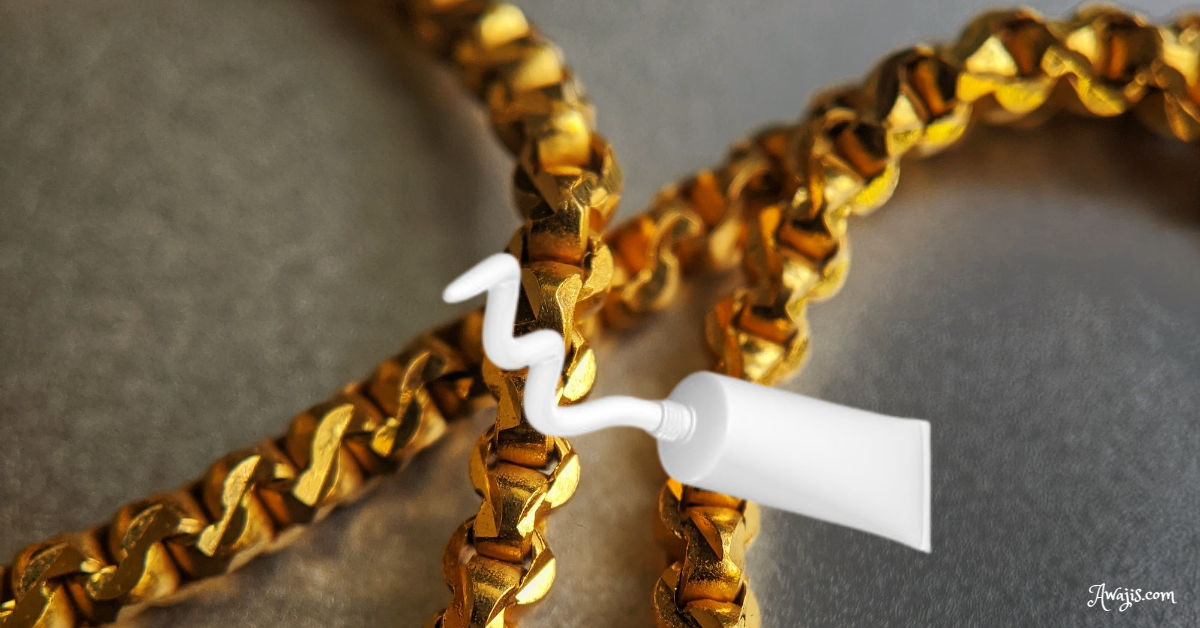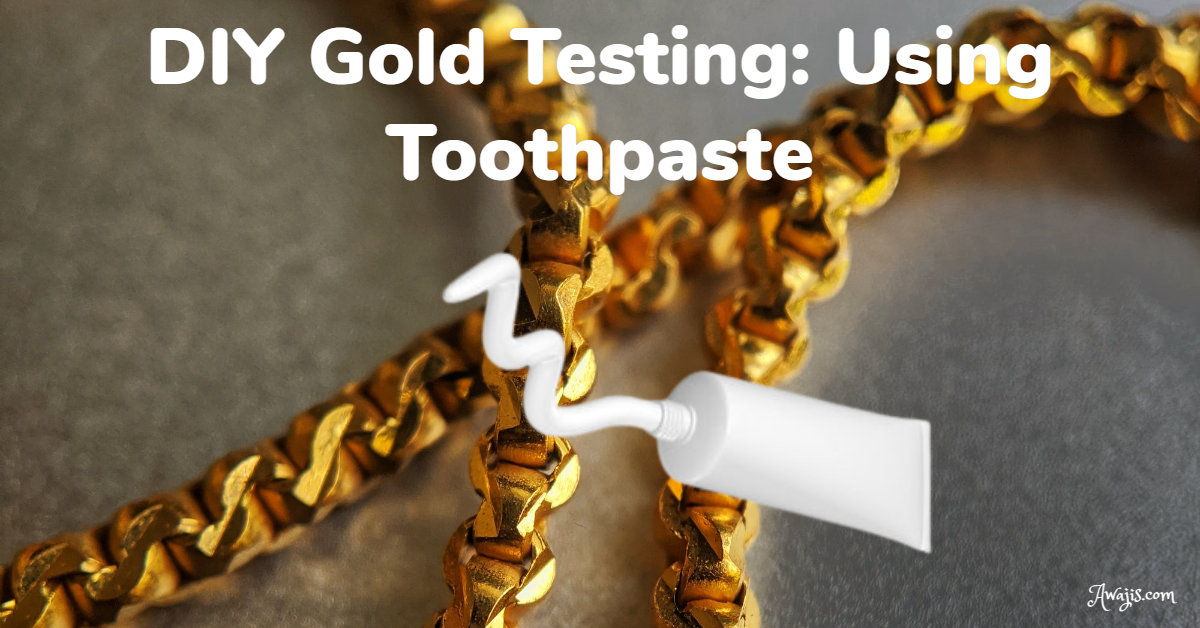How to Test Gold at Home with Toothpaste
How to Test Gold at Home with Toothpaste – Gold is one of the most stable and inflation-proof investments; it has a long history of use as jewelry, decorative things, and currency.
Gold’s high thermal and electrical conductivity properties make it a popular choice for usage in modern technological gadgets.
Also, it’s not uncommon for people to keep gold in the form of jewelry and other mementos at home.
The question then becomes, how can we verify the authenticity of the gold we possess? That’s why we conduct tests on gold. The purity of the gold can be ascertained with a few straightforward tests.
One of the most popular methods for testing gold is to use toothpaste. Yep, toothpaste! There are a few more methods as well.

How to Test Gold at Home with Toothpaste
Note: Although this method is not foolproof, it is a simple and quick approach to verifying the authenticity of your gold.
The following supplies are required to test gold with toothpaste:
- A little nugget of gold.
- Toothpaste (only white toothpaste without any coloration or flavoring).
- Running water.
The 1 minute Toothpaste Gold Test
Here is the step-by-step process to test gold with toothpaste:
- Ready your gold piece (a gold coin, a gold ring, or any gold piece).
- The next step is to put a dab of toothpaste on the gold. Use only white toothpaste; flavored or striped varieties should be avoided.
- Gently rub the toothpaste onto the gold for 30 seconds [Don’t scrub too harshly, or you risk damaging your gold]. You should see a black streak begin to form.
- Rinse the gold piece under running water to wash off the toothpaste, then dry it with a soft, clean cloth. The black streak should vanish, leaving the gold spotless.
- If the black streak vanishes, your gold is authentic! Genuine gold will retain its pretty yellow color and beautiful shine. Unfortunately, if the spot stays, your gold is not genuine.
How come this Test is Effective?
This test works because toothpaste contains a microscopic amount of abrasive particles. These particles function to remove a very thin layer of the gold when you rub the toothpaste against it.
Real gold is unaffected by toothpaste, while fake gold will change color. The presence of other metals like copper or silver causes the black streak to develop.
Faux gold contains metal alloys; specifically, these alloys are typically copper-based, such as bronze and brass, that react to toothpaste.
Again, imitation gold is susceptible to damage when exposed to particular testing methods due to the presence of several alloys in its composition.
Remember that this test will not work on gold-plated items. The toothpaste will remove the thin layer of gold, exposing the metal beneath. So, before testing a gold-plated item, check for the hallmark stamp. This stamp signifies the item is made of genuine gold.
Further, some faux gold items may be immune to the effects of toothpaste, which could lead to erroneous results. So, it is still important to conduct several other tests to determine whether or not your gold is genuine.
Alternative Methods for Testing Gold
There are a few other methods to test gold at home, including:
Magnet Test
Here is the step-by-step process to test gold with a magnet:
- Acquire a strong magnet. Neodymium magnets are best for this purpose, although any strong magnet would suffice.
- Place the gold piece in question near the magnet.
- If the gold attracts the magnet, it is not genuine. Gold is not magnetic; thus, if it sticks to your magnet, it is likely made of another metal.
- But, if the gold is not attracted to the magnet, it is more likely to be genuine.
Karat Test
When referring to gold, the term “karat” is used to indicate the metal’s purity. The purer the gold, the higher the karat number. For instance, 24-karat gold is 100% pure, while 18-karat gold is 75% pure.
Here is how to test the karat of your gold:
- Ready your materials. A gold testing kit is required, which can be purchased at most jewelry stores or online.
- Ensure your gold is spotless. Wipe any grime or dirt away with a clean, soft cloth.
- Then, place the gold on the test stone. The test stone is included in your gold testing kit.
- Now, apply the acid solution. The acid solution will react with the metal to determine its karat purity. Ensure you adhere to the instructions that come with your gold testing kit.
- Finally, compare the outcomes. The color of the acid solution will change based on the karat purity of your gold. A chart is included in your gold testing kit to help you determine the karat purity of your gold.

Float Test
The float test is another method to test your gold. The procedure is as follows:
- Pour some water into a bowl or a cup.
- Drop your gold piece into the water.
- If your gold piece sinks to the bottom, then it is genuine. Since gold is one of the densest elements on earth, a gold piece that is heavy enough to sink is likely to be authentic.
- But, if the gold floats to the top or hovers in the middle of the cup, it’s not genuine.
Final Thoughts
Gold is an expensive commodity; thus, it is essential to avoid being duped. You can verify the authenticity of your gold with a few simple tests using any of the above methods.
It’s not advisable to test gold with toothpaste. Despite its effectiveness in exposing fake gold made from metal alloys, it has abrasive ingredients like modified silica and calcium carbonate that can damage genuine gold.
Therefore, the most reliable method is using a gold testing kit from a reputable jewelry store or retailer.
In cases of uncertainty, it’s best to get an expert’s advice. A professional jeweler can swiftly and effortlessly determine your gold’s purity and quality.
Also check: Why are Golden Goose Shoes so expensive?
We hope you find this information helpful. Please use any of the share buttons below to share this information.
Feel free to drop any questions or contributions regarding this article in the comment section below.
Recommended:
Where can I get Balloons Filled with Helium? [Latest Update]
17 Funny Phone Numbers to Call when you’re Bored
How to Make a Successful Water Leak Insurance Claim [Updated Tips]
